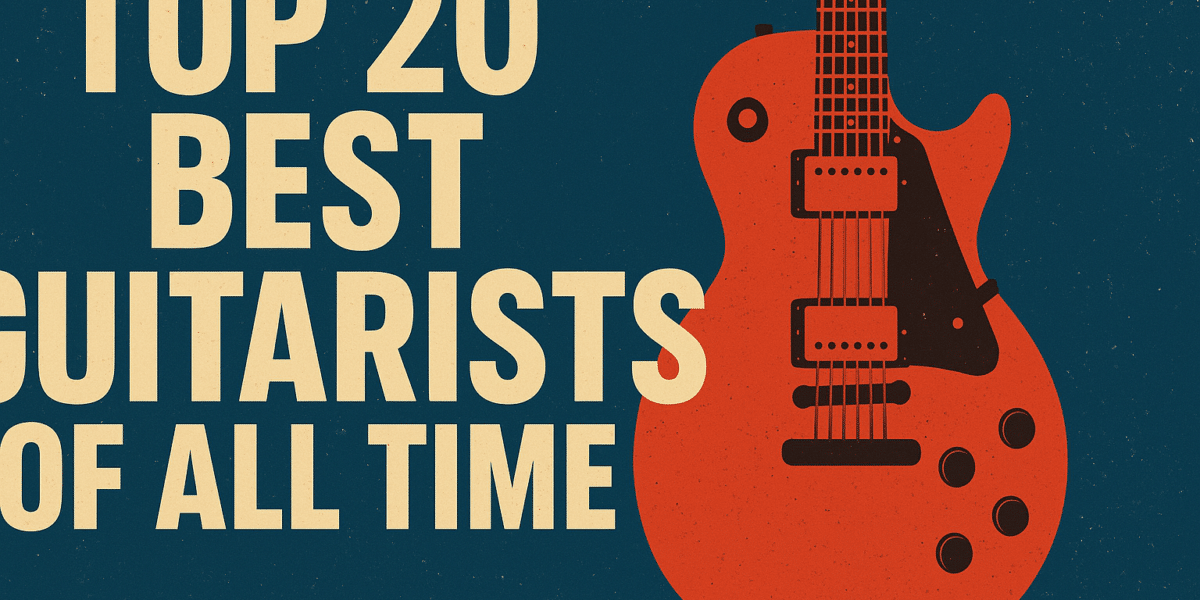Top 10 Best Guitarists of All Time

In modern music, the guitar is one of the most flexible and used instruments. It can produce a wide range of sounds and styles, making it the foundation for many genres.
Throughout the years, the best guitarists of all time have pushed the boundaries of what is possible on the instrument, dazzling audiences with their skill and ingenuity. In this top ten list, we’ll look at the best guitarists of all time, whose talents have influenced how we think about and play the guitar.
The 10 best guitarists of all time in this list come from all walks of life and have left their mark on various genres and eras. Some were pioneers, developing new techniques and sounds, while others perfected old approaches.
They all have one thing in common: they can make the guitar sing in a way that strikes the soul. So, without further ado, let’s look at the top 10 best guitarists of all time.
Top 20 Best Guitarists of All Time
1. Brian May

Arise, Sir Brian Harold May, one of the best guitarists of all time, the most regal player, and the one whose path to the summit began most unconventionally, with a father-and-son woodworking project converting a fireplace into one of the most inventive electric guitars ever made, the Red Special.
May benefited greatly from her home-grown mad scientist sensibility. Simply look at how he used the Deacy amplifier. Using a sixpence as a guitar pick, he created an instantly recognizable sound, a three-dimensional cushion of overdrive that carried Queen’s majestic melodies through the ether.
May’s tone has a textural gourmand quality to it, with a phalanx of Vox AC30s, the Dallas Rangemaster in front, phase shifting, and tape echo.
2. Jimi Hendrix
Jimi Hendrix was the electric guitar’s much-anticipated creative explosion. It’s tempting to suggest that Hendrix was ahead of his time, and this is true. There is a stronger case for why he was born precisely at the correct time.
The gear had advanced enough to handle high volumes and new sounds, rock ‘n’ roll had deflowered pop culture, and the timing was perfect. And if he had been born later, say in today’s climate, would he have been as free to shepherd that tempest of feedback in an era when stage noise, in-ears, and all that jazz are restricted? Will he be lost on TikTok?
For better or worse, Hendrix lived freely in a dangerous age, pushing the guitar to its limits with his newfound technological superpower, the Marshall stack, and the supplemental ordnance offered on the floor by Roger Mayer et al – wah, fuzz, Uni-Vibe, and all those other toys. And he exploited them spectacularly, transforming blues into rock and psychedelia.
The whump-whump pulse of the Leslie effect might knock you sideways at times, but Hendrix knew when to dial it down and let his phrasing, chord inversions, and vibrato speak for itself. His guitar sound was colorful. Oh, so he set fire to his guitar? It was always on fire…
Do you want to download Korean movies in Nigeria, we have listed the Best Movie websites to download Korean Movies with English subtitles
3. Jimmy Page
Years of polishing his chops as an on-call session musician had prepared Jimmy Page for his future role as guitarist and producer of the world’s biggest rock band, a band whose creative ambition matched the scale of their triumph.
Page, like Eric Clapton and Jeff Beck, was a Yardbirds alumni, first playing bass guitar and subsequently guitar, briefly alongside Jeff Beck. The signs were there that Page was going to be a different type of guitarist. He used a bow on his guitar. Like Beck, he recognized the creative possibilities of high-volume, fuzz, wah, and other nice stuff, and he carried those creative epiphanies with him into Led Zeppelin.
Page would be the first to admit that Led Zeppelin’s success was due to the chemistry among the band members. There were no weak links. That meant that everything was conceivable.
Albums I and II featured riff after riff, with Page beginning with his Telecaster, a gift from Beck, progressing to the Les Paul, experimenting with more gear, acoustics, 12-string electrics, Echoplex tape echo, adding layers, and incorporating folk and blues into rock, all emulsified by his singular vision.
And then some solos are teetering on the brink, with the suspense not killing you but leaving you hanging on every note to see whether he can land it. Spoilers: He did.
4. Eddie Van Halen

Eddie Van Halen was one the best guitarists of all time, transforming electric guitar culture into a spectacle on par with the Super Bowl, Hollywood, the aurora borealis, and herds of wildebeest crossing the Serengeti.
EVH accomplished all of this by constantly MacGyvering his gear, putting a Variac to use, monstering a Strat, D-Tunas, and double-locking vibratos, all in search of that tone, the so-called Brown Tone. You know it when you hear it: juicy, full of harmonics, crunch – again, so incredibly electric.
He accomplished all of this by reworking the guitar player’s technique, most notably a method of two-handed tapping that remained exciting in his hands even after a generation had adopted it as their own. However, no one could execute it quite like Van Halen; it always sounded exactly like him. When all is said and done, that is the definition of a great guitarist. They sound like no other.
5. Eric Clapton
The inscription on the walls of 1960s London says it all: “Clapton Is God”. Is theologically unsound? Sure. But back then Clapton was providing plenty of evidence. He introduced himself with The Yardbirds before leaving for John Mayall And The Bluesbreakers.
The band’s studio debut, simply named Blues Breakers with Eric Clapton but better known as The Beano Album, remains a classic. But more brilliance was on the way, and Clapton was in a hurry. He formed Cream with fellow Bluesbreakers alumnus Jack Bruce and recorded some of the most iconic rock songs of all time.
The Marshall stack opened up new possibilities, and Clapton’s ‘woman tone’ brought the electric guitar – in this case, his 1964 Gibson SG – closer to a soul singer’s voice than anyone had before. After Cream, he formed the short-lived supergroup Blind Faith before recording his masterpiece, Layla and Other Assorted Love Songs, with Derek and the Dominos in 1970.
6. David Gilmour
Great civilizations have grown and perished in the time it takes for one of David Gilmour’s notes to fade. Gilmour’s career appears to have been one long struggle against time, a battle to make time dance to his music. Notes are plucked, chosen, and fly over the firmament, welcoming visitors in planetary orbit for tea before elegantly returning to Earth. The impact on the audience is transcendent.
Replacing Syd Barrett in Pink Floyd was not an easy process. Gilmour, on the other hand, possessed the vision, chops, and familiarity with a Binson Echorec to elevate the British progressive rock heroes’ sound to new heights.
7. Ritchie Blackmore
Ritchie Blackmore, hard rock’s “Man in Black,” redefined guitar for a generation. Okay, we’ve reached the point where everyone is redefining things, but he was the one who made the riffs harder and the solos more ambitious with Deep Purple, who looked beyond the Pentatonic shapes and towards classical music for inspiration, classifying and expanding the denim-and-leather demographic.
Of course, he is also a character, which is very important in this game. Blackmore may have been a Renaissance man who enjoyed a bit of Baroque ‘n’ roll when it came to what was there in front of him on the treble clef, but he was also volatile. It was often the case that the geniuses among us had the aura of an unexploded bomb.
8. Alex Lifeson
Rush achieved several artistic accomplishments, but when we look at their entire history, the Canadian trio’s ability to make progressive rock accessible to all listeners is most amazing. The exact method by which they accomplished this remains unknown. Their songs may be Joycean epics, sophisticated and knowing, yet they always oozed compassion, and Alex Lifeson’s note selections and ear for melody supplemented their most ambitious ideas with hooks that drew us in for the trip.
With Lifeson on guitar and Geddy Lee on vocals, prog was for everyone. Or almost everything. Lifeson’s chord choices were inspired, dropping in suspended chords and letting them hang in the air – an evening with Rush was a kind of indoctrination into the musical appeal of the F#11, the sus2, and how open strings might modify a chord voicing and expand the meaning of the song.
Lifeson is so brilliant that he can play a Gibson Les Paul with Floyd Rose double-locking vibrato. That’s a little like painting the Bentley bright pink and wearing plimsolls with a suit, but come on, Alex, you’ve earned it.
9. Jeffrey Beck

Jeff Beck, another talent who emerged from the Yardbirds to carve out a unique career, was the guitar player’s guitar idol. He was the player who abandoned the pick, used his Strat’s whammy bar like an extension of himself, and spent his entire career chasing down every dynamic he could find in the instrument.
The guitar was already electric when Beck picked it up, but there was always the sensation that he had hacked the grid and increased the voltage, ushering in a new era of high volume, fuzz noise, and feedback, not to mention that it sounded just as fine whispering as shouting. Stick on Shapes of Things today, and the Yardbirds’ breakthrough song still sounds as fresh as a daisy.
10. Slash
You couldn’t imagine Slash working a regular 9-to-5, coaching little league, and varnishing the fence on his YouTube. If there was a man born to be a rock star… Where do you start with Slash? Well, Appetite For Destruction, Guns N’ Roses’ incendiary 1987 debut album is as good a place as any. It still sounds dangerous, bad for the
Of course, GNR is the sum of its parts – Axl straining at the leash, popping veins at the mic, Steven Adler hitting the drums with all he’s got – but Slash’s animalistic style, ripping leads, and knowing when to pull focus with a big set-piece melody were the main ingredients, introducing arguably the last great rock guitar hero.
In many ways, Slash was and remains a throwback. He revived Les Paul in an era when hockey stick headstocks were gaining popularity, and he did so with a fake. He was on a different level, swaying back and forth between the major and minor, creating a spectacle of rock guitar in one instant, unveiling its sordid underbelly the next.
Conclusion
These top 10 Best guitarists of all time were pioneers and innovators who took the electric guitar to new heights, inspiring musicians today. Each had a distinct tone that made it simple to recognize the guitarist while hearing one of their songs, solos, or riffs. Whether it was rock or heavy metal, they improved the performance style. They are true guitar heroes.





